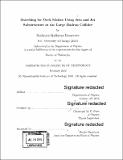Searching for dark matter using jets and jet substructure at the Large Hadron Collider
Author(s)
Narayanan, Siddharth Madhavan.
Download1134391194-MIT.pdf (22.56Mb)
Other Contributors
Massachusetts Institute of Technology. Department of Physics.
Advisor
Christoph M. E. Paus.
Terms of use
Metadata
Show full item recordAbstract
Astrophysical observations of gravitational interactions provide strong evidence for the existence of dark matter. Many theories propose and experiments test the hypothesis that dark matter may have a particle physics origin, but this remains unproven. One such experiment is the Compact Muon Solenoid at the Large Hadron Collider. If dark matter couples, at least lightly, to the Standard Model, then it is possible to produce it in collisions at the LHC. Because it would not interact with the detector, we must look for collisions in which dark matter is produced in association with one or more SM particles. This thesis describes two such analyses: dark matter plus one top quark and dark matter plus two light quarks. Both cases result in complicated detector signatures due to the hadronization of final-state quarks. Recently developed jet substructure techniques were applied using novel methods to identify the hadronization products of high-momentum top quarks. In both analyses, the observed data is found to be consistent with SM backgrounds. We translate these results into the most stringent constraints to date on the relevant beyond-SM models.
Description
Thesis: Ph. D., Massachusetts Institute of Technology, Department of Physics, 2019 Cataloged from PDF version of thesis. Includes bibliographical references (pages 155-163).
Date issued
2019Department
Massachusetts Institute of Technology. Department of PhysicsPublisher
Massachusetts Institute of Technology
Keywords
Physics.